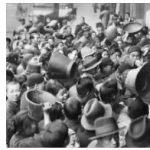In addition to all this magnificent series of industries, which behind the call of the fossil treasure have nestled almost entirely inside the open corridor of the Haine-Sambre-Meuse, the textile industries, ancient glory of the Belgium. The famous cloth factories, which made the glory and wealth of Bruges, Ghent, Ypres (Yperen) in the 10th century. XII-XV, are today only a memory, but the modern wool industry still has one of its most famous production centers in Belgium, as Verviers and the surrounding district, taking advantage of the fortunate properties of the waters of the Gileppe (tributary of the Vesdre), particularly suitable for washing wool, centralize more than half of Belgian wool processing, treating more than 40 million kg annually. of raw wool. The Flemish provinces, for their part, replaced the lost glory of the wool mill after the century. XVI that of the linen mill, still concentrating today the industry of yarns and fabrics, laces, batiste, linen veils around Courtrai (Kortrijk), center of linen cultivation, and more in Ghent, where they work, in addition to macerated Belgian linen in the most suitable waters of the Lys, nine times more than imported flax. The cotton industry finally triumphs from the century. XIX in Ghent, which soon became the Manchester of Belgium (28 spinning mills with 1 million spindles, 67 weaving mills with 19,000 looms). The home lace industry continues to this day in the countryside of Flanders and in the district around Brussels. In summary, the Belgian textile industries keep their old fame high,
The aviation industry also deserves a mention, which while in the past it depended directly on foreign countries, has received a great boost in recent years. The main factories for the construction of aircraft are: the Belgian limited company of aircraft construction (SABCA), which is the most important factory for military and transport equipment, based in Brussels: it has a capital of 10 million francs; Stampe et Vertongen, with a workshop in Deurne Sud, Antwerp: specialized in the construction of school and training equipment; the Zacco, from Zeebrugge, with workshops in Brussels. The only Belgian factory for the construction of aircraft engines is Renard, set up in 1927, with workshops in Brussels.
In total, the investigation into the situation of the Belgian industry carried out in 1926 gave 190,000 people employed in the mining industries, 227,000 in the metal industries, 172,000 in textiles (with a notable decrease since the war), 30,000 in ceramics, 37,000 in glass., 145,000 in transport, etc. The 1920 census raises the number of people employed in industries to 470 per thousand of the population (excluding children), in commerce to 180 per thousand, in agriculture to 152; therefore two thirds of the active population practices industry or commerce. Only the provinces of Limburg and Luxembourg give the most of their residents to work in the fields. For Belgium economics and business, please check businesscarriers.com.
It is easy to understand how such an industrial development must be matched by a commercial development of equal importance. In fact, Belgian industry could not live without a grandiose import of all the raw materials that the country does not produce (iron and zinc ores, wool, cotton, linen, timber, rubber and so on), nor could it live without then. exporting the manufactured products that the country market cannot absorb: a third of the products of the Belgian industry are in fact exported, and more than half of their products export the textile industries, two thirds the metallurgical ones, nine tenths the glass industries. On the other hand, imports are not only essential to keep industries alive, but they are also very much needed for the daily nutrition of the very dense population: in fact, despite the intense agricultural production, Belgium has only a fifth of what it needs for its annual nourishment of wheat, and in varying degrees other cereals, meats, dairy products, eggs, and so on, are lacking the most urgent needs. For all these reasons, it can be explained how, despite its smallness, Belgium is among the largest smuggling nations: its foreign trade represented in 1910 a sum of 520 francs per resident, just below Great Britain, far below. above Germany (240) and France (230); the total figures of foreign trade in the pre-war period were considerably higher even than those of Italy, five times more populated, and today they are higher than those of Spain, Poland and other of the more conspicuous European states. In 1926’s 1 / 2 to € 2 billion). Main importing countries: France, Great Britain, United States, Netherlands, Germany; main exporters: Great Britain, France, the Netherlands, Germany, while Italy only appears with very low percentages (from 1 to 2 per cent).
Of primary importance is also the transit trade (in 1925, 14 billion francs), since, thanks to its geographical position, Belgium serves as an outlet to the sea for the industrious Rhenish districts and on its soil the exchanges of Great Britain and overseas countries with a large part of Europe in between. In which the exceptionally favorable situation of the port of Antwerp, which concentrates nine tenths of all the state’s trade, enters as a decisive factor.







